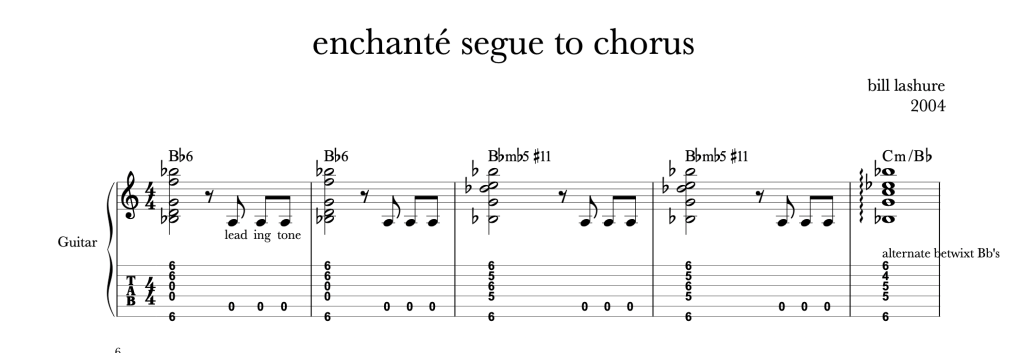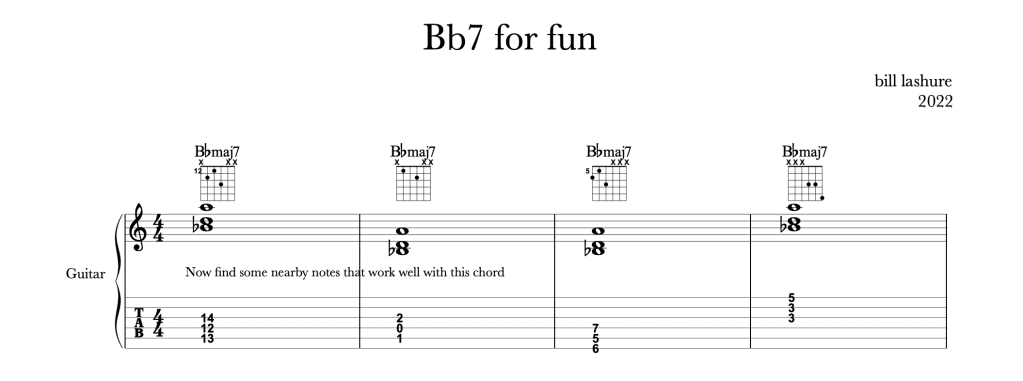
video LINKS to B flat major scale on the guitar
Some video’s displaying ‘the sonique spiderweb’ and its utility.
B flat major scale demonstrated at various positions on the fretboard
B flat major chord built from the triad of Root, Major 3rd and Perfect 5th.
C minor chord built from with in the B flat major scale.
bref
NOTE NOTES
So in dealing with the B flat Ionian we can use the sonique spiderweb further by building relative chords found with in the scale.
Most chords have a Root, a 3rd (major or minor) and a 5th.
A triad of 3 pitches, these pitches can repeat with in a chord to give it a fuller sound.
Or …., which also gives the chord a unique flavor.
(you can fill in the blank, I learned recently that leaving something to the imagination is pertinent to the readers expectation whilst digesting information and can more actively engage the mind more than spelling everything out! [this is going to happen some more just so you’re aware, this is a teaching effort after all])
Looking at the sonique spiderweb with the B flat Ionian on display we can see on the outer perimeter the Root Major 3rd and Perfect 5th being displayed
Bb D F
The premier triad.
By following that pattern around the sonique spiderweb we next come to C Eb G
A root pitch C a minor 3rd Eb and a perfect fifth G
Notice how we skip a displayed pitch to get to the 3rd and 5th
The outer perimeter of the web does not indicate these intervals, the relationship of intervals remain static.
Root > m2nd > M2nd > m3rd etc..
It is how we are using them in this context that their definition changes.
Above are a couple of videos demonstrating the chord assembly technique available in the sonique spiderweb as well as fretboard examples.
Your mission should you decide to accept it is to follow the pattern all around and ….?
See I told you you would have to use your imagination.
speaking of imagination
PERFORMANCE NOTES
So I gave my keyboard an erection recently.
Yep raised the stand it sits on so that I have to stand to play it or get a taller stool!
I find it offers a challenge and a way of focusing my thinking, changing up my position that sitting sometimes does not allow.
It is incredibly easy to get caught up in thoughts that are in no way focused on the task at hand, and subsequently distract from said task.
In this case, the practice of an instrument I am determined to get better at.
So changing my position in an effort to gain some focus is helpful.
Also I want to improve my vocals so standing helps with that as well.
To stand or sit whilst playing the guitar is also something to consider.
There are advantages to each.
The closer the guitar is to your chest can make playing certain things easier.
But for looking cool, a guitar slung low off the shoulder while standing really sets a mood, (I wanna rock!)
But that can make some playing techniques difficult to manage.
Take a look at your favorite performers at various points in a performance.
Do their instruments proximity change from time to time depending on the song being performed?
Even while sitting movement can be detected to enable reaching certain portions of a piece practical.
When playing do you watch to pick hand or your fret hand?
What can we learn from this?
What does it tell us we know or don’t know while looking at our instrument?
Close my eyes during practice.
I do this with the keyboard from time to time in hopes of becoming better acquainted with it.
Try to get a feel for where my hands need to be.
I did this whilst jamming with some friends with the guitar recently, but that was more to focus on the sound we were making.
To listen more I shut my eyes to limit sensory input so my brain could process the sound more closely.
With the end goal of getting the song we were playing to sound good!




